Golden Ages of Russia / Imperial Academy of Arts Vice President medal
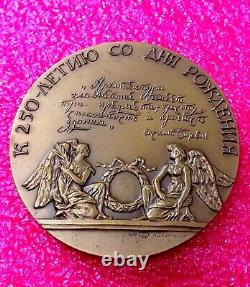
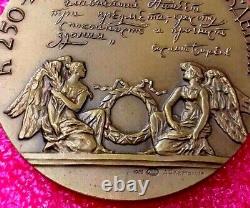
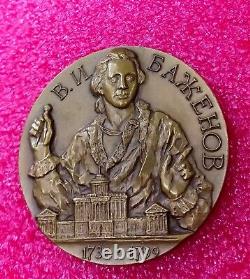
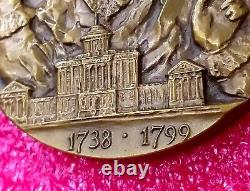
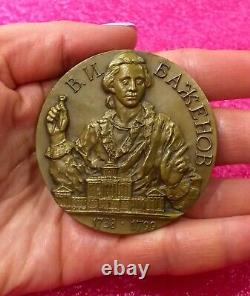

Medal Size 60 mm, 130gr, St. Tsaritsyno Palace and Park Ensemble. Project of the Kremlin Palace.
Russian architect and theoretician of architecture and educator, representative of classicism. Member of the Russian Academy.
Since 1784, vice-president of the Academy of Arts. Buildings of Bazhenov in Tsaritsyno. Fragment of a family portrait. 1770s From the collection of GNIM them. Bazhenov is usually called either Moscow or the village of Dolskoye near Maloyaroslavets.
(in the modern Maloyaroslavets district of the Kaluga region). As a child, he discovered a natural talent for art, sketching all kinds of buildings in the ancient capital.
This passion for drawing drew Bazhenov to the attention of the architect D. Who was appointed in 1754 the chief architect of Moscow University. Who accepted him to his school. On his recommendation, Bazhenov in April 1755 entered the gymnasium of Moscow University.
Where he was enrolled in a special "art class", intended for the future Academy of Arts. Among the 9 best students, Bazhenov in 1756, at the initiative of I.
Was transferred to an academic gymnasium in St. Petersburg, and after the opening of the Academy of Arts. In January 1758, he was accepted into its students.
At the Academy, his abilities for architecture were revealed to such an extent that the professor of architecture S. Made a talented young man his assistant in the construction of the St. Bazhenov was sent to develop his talent in Paris. The first pensioner of the Academy of Arts. Having entered the apprenticeship with Professor Charles Devaya.
Bazhenov began making models of architectural parts made of wood and cork and performed several models of famous buildings. In Paris, he made, following the strict proportionality of parts, a model of the Louvre Gallery. And in Rome - a model of St.
And other masters of French classicism of that time" to taste the grandiose scale of designed structures, whose compositions, layout and decor contained complex, often Masonic symbols ". And were not always feasible in reality. Upon his return to Russia, living in Moscow, Bazhenov participated in the publication of the work of Vitruvius.Bazhenov was one of the best construction practitioners of his time, distinguished by both the art of planning and the grace of the shape of the designed buildings (which he fully showed after returning to his homeland). He was one of the conductors of the so-called. French taste (style) in Russian architecture, a striking monument of which is the Pashkov House. He showed his skills in the academic program for the degree of professor of a complex of entertainment facilities for Catherine; however, Bazhenov did not receive the expected position and took a dismissal from the academic service, after which Prince G.
Appointed him to his Artillery Department as chief architect with the rank of captain. In this position, Bazhenov allegedly built the Pashkov house. In Moscow , and in the vicinity of the capital - the palace complex in Tsaritsyno. On the site of the fortress walls overlooking the Moscow River, the architect designed the Forum of the Great Empire or the Grand Kremlin Palace. The complex was designed as a grandiose community center with a theater and an oval square for public gatherings, which all the streets of the Kremlin were supposed to converge on.In this case, the historical context was practically not taken into account: many of the pre-Petrine buildings of the Kremlin were supposed to be demolished, at the same time closing the overview of the temples of Cathedral Square. From the side of the river. That would inevitably distort the historical appearance of the stronghold. The Kremlin walls had already begun to be dismantled (demolishing part of the six-tower wall section facing the Moscow River), but when digging a pit at the foot of the Kremlin hill, cracks appeared on the walls of ancient cathedrals, and, by the will of the empress, the construction was postponed, and then completely abandoned in 1775.
; the demolished part of the Kremlin walls was later restored by MF Kazakov. The same fate befell the tsaritsyn ensemble of Bazhenov, which was an innovative fusion of elements of the Naryshkin baroque of the. Late 17th century and Western European Gothic decor. Bazhenov first tested this combination.
On temporary entertainment pavilions of the Khodynka field. Where the conclusion of the Kyuchuk-Kainardzhi peace with the Turks was. Catherine in the summer of 1785 came for three days to the throne, visited the construction of the palaces in Tsaritsyno (her own and the grand-ducal) and, outraged by their equal size, ordered them to be demolished; the architect was removed from the project. At the same time in Moscow, Bazhenov made an attempt to organize a "particular" (private) academy and recruit students.
Apparently, the idea failed, because, according to Bazhenov, there are many obstacles to my intention. Until now, Bazhenov is credited with the lost monument of St. Petersburg, the Old Arsenal on Liteiny Street (in the XIX century it was occupied by the District Court, burned in 1917, dismantled in the late 1920s); but, most likely, the architect has nothing to do with it. The construction of the building began under the guidance of the architect of the Artillery Department V. Von Diderichstein in the spring of 1766.
And was carried out by the architect of the Engineering Corps K. Bazhenov at the end of 1766 entered the Artillery, but soon left for Moscow. A large number of documents on this topic have been preserved in the funds of the VIMAIViVS Historical Archive ("Archive of the Artillery Museum") in St. A large bridge over a ravine in the estate of Tsaritsyno. One of the few surviving buildings, the authorship of Bazhenov in respect of which is precisely established. Vladimir Church in Bykovo is. Attributed by some authors to Bazhenov. A member of the Moscow box. Of Deucalion, which was led by. It was elevated to a "theoretical" degree, where he also worked under the direction of S. Entered the box "Laton", headed by N. Left without any means of livelihood, Bazhenov opened an art institution and took up private buildings.The change in his career and the disfavor of Catherine are explained by his complex, proud disposition, as well as his relationship with the circle of N. Who instructed him to report to the heir to Paul I. About the choice of the latter by Moscow masons as the supreme masters. In these relations with the prince, Catherine suspected political goals, and her anger fell on Bazhenov earlier than on others; but things didn't go further than exclusion from the service, and in 1792 he was again accepted to the service by the admiralty board and transferred his activities to St.
Without any reason, he was credited with the Kamennoostrovsky Palace. The palace of Grand Duke Pavel Petrovich on Kamenny Island and work in the Gatchina Palace. Documented only confirms his participation in the development of one of the projects of the Mikhailovsky Castle. Petersburg researchers have established, the authorship of this grandiose structure cannot be attributed only to Bazhenov. Work began long before the construction and was "dictated" by Pavel Petrovich, who sketched out plan sketches, first by A. The architect of the Small Court. Then - in the 1790s - Bazhenov joined in, but the final draft was drawn up by V. It was he who was realized. After his accession to the throne, Pavel I.Who approached all those persecuted by his mother in general, appointed Bazhenov vice-president of the Academy of Arts and instructed him to prepare a collection of drawings of Russian buildings for a historical study of Russian architecture, as well as provide an explanation on what should be done, to communicate the proper progress to the development of the talents of Russian artists at the Academy of Arts. Bazhenov eagerly began to carry out the gracious orders of the monarch, who showed himself to be the patron of domestic art; he could have done a lot, no doubt, if death had not unexpectedly stopped his life. Bazhenov was buried in the Smolensk Orthodox cemetery. But in 1800 his remains were transferred to the Bazhenov estate in the village of Glazovo now Yasnogorsky district. "There is practically nothing left of Bazhenov, there is only one Pashkov house against the Kremlin, and all that remains is the façade, everything is destroyed, and it's still not known whether Bazhenov built it, " states Grigory Revzin.
Nevertheless, the romantic image of Bazhenov as an unrecognized genius, whose grandiose designs were not appreciated by authoritarian authorities, became widespread in the Russian mass consciousness, especially in Soviet times, when they had to be associated with the name of Bazhenov to save these or those abandoned buildings. As a result, almost all the pseudo-Gothic constructions of the late 18th century in the Moscow region were attributed (or continue to be attributed) to Bazhenov and Kazakov. At one time or another, the authorship of which did not preserve documentation.Only two projects of Bazhenov are reliably known - the Kremlin and Tsaritsyno. Almost all architecture historians mention his name in connection with the Pashkov house, which in its decision echoes the unrealized project of the Kremlin forum. The attribution to Bazhenov of all other buildings, especially in the outback (where Bazhenov never worked according to documents), is purely divinatory, and in some cases arbitrary.
The project was redesigned by Vincenzo Brenna. Registration of the Khodynsky field.
In connection with the festivities in honor of the end of the Russian-Turkish war. Most of the buildings were demolished or rebuilt almost immediately at the behest of Catherine II. And the palace of I. In the village of Golovkino. The project of the Kamennoostrovsky palace of.Only speculation; construction work was carried out by Felten. In the village of Krasnoe. Rumyantsev's estate on Maroseyka. Grieving Church on Bolshaya Ordynka. Church of the Vladimir Icon of the Mother of God (Nativity of Christ) 1789.
Buildings of Bazhenov in Tsaritsyn. Road to the Figured Bridge. Big bridge in the park. Grape bunch in the arched gate. The building of the Smolny.
The project received praise, but the building was erected according to the project of Giacomo Quarenghi. Construction started, but stopped in 1775. Due to the threat to the ancient monuments of the Kremlin.
Galernaya harbor restoration project on Vasilyevsky Island. (rejected due to high cost).
Workshop design for the Admiralty. Project arena and Arakcheev barracks near Smolny. Participated in the design of the Kazan Cathedral 1797. Monument to Bazhenov and Kazakov. This item is in the category "Coins & Paper Money\Exonumia\Medals".
The seller is "top-art-medals" and is located in this country: IL.

